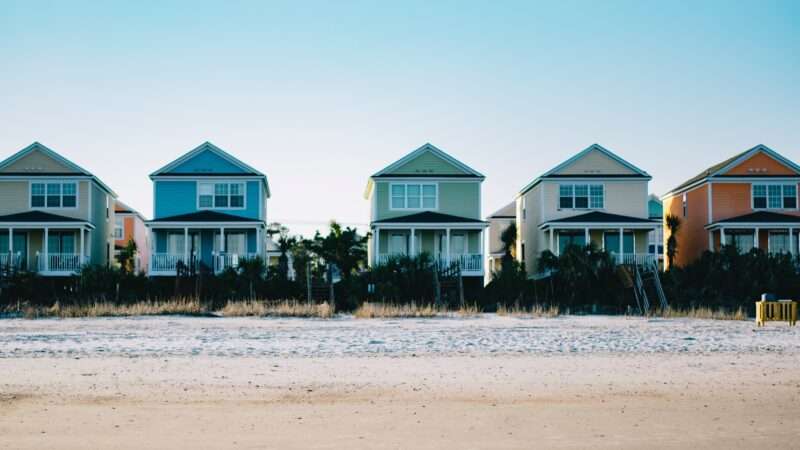
One of the more entertaining aspects of the state’s battle to open up housing development to reduce California’s housing shortage is the degree to which it has united officials in liberal coastal cities with those in conservative ones. Although Left and Right typically use different rhetoric to evade new housing bills, they are strangely aligned in their ultimate quest to block permissive new construction laws.
Republican-controlled Huntington Beach, which has sued the state government to stop enforcement of state housing mandates (and was sued first by the state for its failure to process “by right” duplex approvals under Senate Bill 9), has championed the “local control” argument and stoked NIMBY (Not In My Back Yard) fears about turning this suburban city into an urban hell-scape.
In a column, GOP Mayor Tony Strickland vowed the city will never be “rubber stamps for Gavin Newsom’s vision of turning every community in California into his failed experiment of San Francisco, America’s worst city, whose decline began on Newsom’s watch as mayor there.” Strickland lives in an “affordable-housing” unit and presumably his neighborhood has yet to turn into the Tenderloin.
In lefty near-coastal Beverly Hills, Councilman John Mirisch is raising a different specter—that pro-housing advocates are following the model of Texas, which has usurped local control on social issues including gun regulation. Mirisch also complains about corporate profits, the “urban growth machine” and the evils of “deregulation,” but arrives at the same place as Strickland in opposing freer housing markets. Strange bedfellows.
Now, other coastal NIMBYs—who claim to stand up for principle, but seem allergic to newcomers moving into their cities—have something new to get agitated about. Senate Bill 423 is still alive in the California Legislature. It would extend the provisions of a landmark 2017 law, Senate Bill 35, which authorized a “streamlined, ministerial approval process” for multi-family projects in cities that aren’t meeting their state housing mandates.
That law sunsets in 2026, but S.B. 423 would extend it for another decade. What’s really got the no-growth cities upset is one short line in the bill language: “Strikes out S.B. 35’s exclusion of the coastal zone.” Existing law requires projects to still gain approval from the slow-growth California Coastal Commission. That would end and developers would no longer have to endure that excruciating process. Amendments that exempt additional coastal properties have resulted in the commission removing its opposition to the bill.
Why is this important? S.B. 35 had a measurable impact on the construction of affordable housing projects. “Between 2018 and 2021, developers proposed about 18,000 housing units statewide under S.B. 35—including about 13,000 low-income units, according to preliminary data from UC Berkeley’s Terner Center for Housing Innovation. Of those, more than 11,000 qualified for streamlining under the law,” The Mercury News reported.
Another significant provision of S.B. 423: it expands the streamlining to market-rate projects. That might not create many additional units given that, as Reason‘s Christian Britschgi has noted, pro-union prevailing-wage laws make it costly to build these projects without subsidies. Still, it’s important to expand deregulation beyond subsidized projects. If the government stops stifling construction and imposing overly burdensome and arbitrary regulations, the market will rise to the occasion, boost supply, and open up housing at all price points.
Developers should be free to build more of everything—from single-family houses to apartments—without subjective approval (while following zoning rules, as the bill requires). Few current residents want more congestion, and yet-to-be new residents don’t get a say, so the local default position often is “no”. Councils often force developers to reduce the number of units when they do OK a project. And California Environmental Quality Act (CEQA) lawsuits derail or delay projects.
The bill’s opponents continue to throw contradictory arguments at the wall. In their letter of opposition to S.B. 423, some coastal city officials in San Diego County argued: “The fabric of our coastal communities will be forever changed. And for what? SB 423 will encourage higher density and perpetuate gentrification with little to no affordability.”
The letter adds that rents for one-bedroom apartments in North San Diego County start at $5,750 a month and new multi-family homes are selling for nearly $3 million. It’s true many newer units are pricey, but adding supply—including the construction of the rent-restricted units this bill encourages—is the best way to moderate pricing. More supply is the solution. Protecting a community’s “fabric” is pabulum—and it locks in the current situation.
Environmental groups are complaining, also. They pay lip service to the need for more housing construction—but like the coastal cities apparently want it built anywhere else. That’s the bottom line. The state has been underbuilding housing for years, which has led to eye-popping prices, especially in sought-after coastal cities. The answer is to build more. Sorry, but building it in someone else’s backyard is no longer an option.
This column was first published in The Orange County Register.
The post California Coastal Cities' Housing Plan: Build Elsewhere appeared first on Reason.com.
from Latest https://ift.tt/YZ8y2mX
via IFTTT